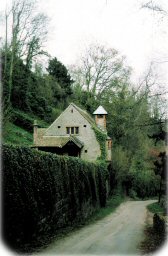‘A Hidden Gem’ (St John the Baptist's Chapel) - Matlock
This is a copy of an article published in The Peak Advertiser,
the Peak District's local free newspaper on June 1994,
reproduced by kind permission of its author, Julie Bunting.
A HIDDEN GEM IN MATLOCK
A Contract with the Rector The chapel being unconsecrated, Mrs Harris was able to install fittings which would not have been tolerated in the parish church of St Giles, and she obviously intended it as a haven for Anglo/Catholic worship. Central to the rood beam is a crucifix on an ornate wooden cross, while Stations of the Cross are positioned around the walls. At the rear of the chapel is a further personal indulgence - a memorial engraved ‘In most loving memory of Vida. L.S.H. Till the last and brightest Easter Day be born’. Vida was Mrs Harris's pet dog. Passionate in her care for animals, Mrs Harris left £1,000 each to the RSPCA and Battersea Dogs Home. A plate in the chancel commemorates the dedication of the chapel to the memory of John and Louisa Graves, presumed to be the parents of Mrs Harris. The only other memorial is to the foundress herself, who died in 1908, and her husband. Mr Harris was a solicitor, which perhaps explains how he came to have a contract with the rector, under which Mr Harris would play the organ here and in return the rector could choose the hymns. The four-panel oriel window is matched by two panels further along the south wall. There are no windows in the north wall. The east window glass is by Louis Davies, whose work was thought by some ‘to verge dangerously on the sentimental’, a comment prompted by the sweet, childlike features of his figures, here used to illustrate scenes on the theme of water; St John the Baptist is depicted with wings behind his camel-hair coat. Red Roses and Purple Grapes Davies called upon 16th/17th-century tradition in designing the moulding of the semi-octagonal plaster ceiling, its ribbing painted with alternate bands of red roses and purple grapes, with small birds flying across the arches between them. Low oak panelling extends around the walls below neat red brickwork, so fresh that it belies its age. Oak pews provide seating for about 80 people, the pew ends gracefully curved but plain, whilst fine carving pierces the priest's and choir stalls. Art nouveau hearts and stylised flowers are echoed in the pulpit, carved by Cecil Fabian. Mrs Harris could clearly afford the best. Despite the fact that its foundress left £10,000 for the upkeep of her beloved chapel, financial problems are never far away. It does have some protection as a listed building but owes a great deal to the ongoing efforts of The Friends of Friendless Churches Trust.[1] © Julie Bunting Reference |
||||
